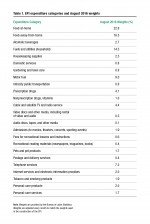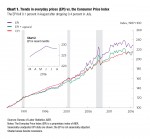Gas Prices Drop and Apparel Increases Slow, Lowering Everyday Prices
AIER’s Everyday Price Index fell 0.1 percent in August from July, driven down by a 3 percent drop in gasoline prices. The EPI measures price changes that people see in their everyday purchases, such as groceries, gasoline, utilities, and personal-care services. Over the past 12 months, the EPI has fallen 1.3 percent.
The EPI including apparel, a broader measure, was unchanged in August and has fallen 1.2 percent over the past 12 months. Both EPI measures exclude prices of infrequently purchased, big-ticket items (such as cars, appliances, and furniture) and prices that are contractually fixed for prolonged periods (like housing).
The more widely known price gauge, the seasonally adjusted Consumer Price Index reported by the U.S. Bureau of Labor Statistics, rose 0.2 percent in August. Prior to seasonal adjustment the CPI increased 0.1 percent for the month and moved 0.8 percent higher over the past 12 months. The EPI is not seasonally adjusted, so we compare it with the unadjusted CPI.
Gasoline prices fell 3 percent in August, their second consecutive decrease after dropping 5.5 percent in July. That more than offset a 0.3 percent increase in prices for household fuels and utilities. The ongoing drop in gas prices is in part due to elevated production and inventories of crude oil. Domestic crude production peaked at 1.9 million barrels a day in 2015 and remains at 1.7 million barrels a day, 42 percent higher than in 2012. Inventories of gasoline also remain high. When oil prices peaked in 2014, gasoline inventories stood at 31 million barrels, and they have only declined to 26 million barrels.
With back-to-school in full swing and fall just around the corner, consumers are shopping for clothing. Apparel prices, when included in the EPI, account for 8.1 percent of everyday prices, the largest share behind food and energy. Apparel prices have increased only 0.3 percent over the past year compared with a 0.5 percent average growth rate over the past five years. Prices for women and girls’ clothing dropped 0.8 percent over the past year after showing no change over the past five years, and footwear dropped 0.5 percent this year compared with a 1.2 percent increase over the past five years.
Apparel prices have shown slower growth than other important everyday prices, such as prescription drugs and event admissions, because of low input prices and a favorable U.S. dollar exchange rate. Prices paid by apparel wholesalers have risen 0.7 percent over the past year, less than their five-year average increase of 1.1 percent. Much apparel is imported, and a rising U.S. dollar tends to restrain import prices. The U.S. dollar has appreciated close to 20 percent since 2014. The effect of the favorable exchange rate is reflected in imported apparel prices, which have fallen 0.4 percent over the past two years.






